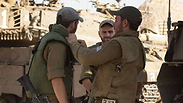
A new kind of ground operation in Gaza
The IDF has learned from bitter experience, but sending troops into the Strip will be neither a picnic nor a walk in the park.
Friday night saw increased military traffic on the roads around Gaza. It was fairly obvious, even to those who just walking around the area, that this was the end or the near end of an amassing of forces for the first stage of a ground operation. The latest units are arriving at well-hidden meeting points and the military police are not letting anyone watch.
This lesson was learned during Operation Pillar of Defense, when troops were crowded in, unprotected in staging areas that visible to all. Then-Defense Minister Ehud Barak and the IDF very much wanted those in Gaza to know that there were many troops and reservists in the field.
Barak was a proponent of the school of "effects-based warfare." In Lebanon, this was a preferred method of operation, but what during Pillar of Defense the Gazans could, even without binoculars, see the thousands of soldiers scattered around the area and knew to aim mortar shells and rockets at them, causing casualties among the soldiers and reservists.
But now, on Friday night, there is small chance that this scenario will be repeated. The Gazans cannot see the massive troop build-up just waiting for the command to move. It could happen at any minute – and it might not happen at all.
In the meantime, the war of attrition continues, and the missile is just waiting to be launched from the Gaza envelope. We were reminded of the attack on IDF troops in Pillar of Defense as we passed Nahal Oz on Friday night, and were warned that the area was exposed to anti-tank missile fire. Indeed, there was a hit Friday evening right on IDF vehicles in the very same spot, and two soldiers were lightly wounded.
For now, it seems there will indeed be a ground incursion, and soon. Of course, one cannot specify how the ground operation will be conducted, but obviously it will not be a repeat of the very demonstrative incursion into Gaza from Operation Cast Lead in 2008. IDF Chief of Staff Benny Gantz pored over the deployment of forces and the operational plans, and 10 days ago approved them. The forces are in place, the plans are in place, and Hamas is in for some surprises.
But we must not delude ourselves; this will be neither a picnic nor a walk in the park. But the operation has been well prepared for a long time, and several months ago GOC Southern Command Sami Turgeman personally approved the attack plan for each combat team commander participating in the operation. There has also been intensive intelligence-gathering that should improve the ability to deal with what Hamas has in store. Therefore, one can assume that the risk to the troops going in is a reasonable one, and there will be a minimum of unnecessary complications.
Until then, Hamas and Islamic Jihad will continue to get a pounding from the air. There are also 155mm cannons bombarding vulnerable locations on the ground, to deter free movement by Hamas fighters. The Gaza beachfront is the recipient of artillery fire and missiles launched from the sea. Even so, Hamas keeps up the continuous rocket and mortar fire - which quite rightly begs the question of how, if the IDF has been attacking for four days with thousands of precision-guided munitions, is there still no reduction in the rocket fire? On the contrary, it's increasing.
The explanation is that the IDF, instead of focusing on the Sisyphean hunt for rocket launchers, which will take a long time and won't be that effective (the firing is done much of the time from civilian areas), is focusing its attacks on targets that will damage Hamas' military capabilities, knowing that this is most painful for them. The goal is long-term impact - both on Hamas ability to rebuild its rocket systems and to hide them underground.
Furthermore, given that their tunnels were dug by Hamas fighters in order to move themselves and tons of explosives into Israeli communities surrounding Gaza, the attacks are centered on demolishing them and preventing further tunnels being created. The militants are trying to reinforce these tunnels with concrete, as well as produce the long-range rockets of which Hamas and Islamic Jihad are so proud.
But the IDF and the security cabinet know that there is one thing that works to our advantage: Unlike after previous operations, this time Hamas has no political sponsor (such as Iran, Egypt, Qatar or Turkey) to facilitate the rehabilitation of the firing and tunneling capabilities destroyed by the IDF, either solely from the air or from the ground as well.
As night fell on the Gaza perimeter Friday, a few more volleys were fired as an appetizer for the meal to break the day-long Ramadan fast. Driving north, it was clear that the question now is when the ground operation will begin, not if. Developments in the coming days will see that question answered.










